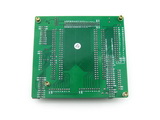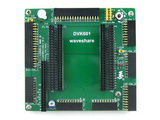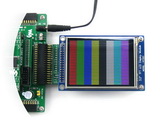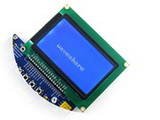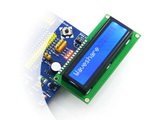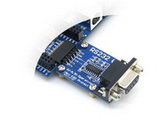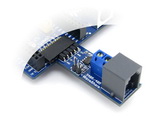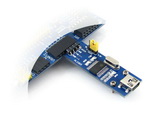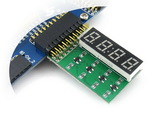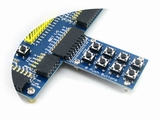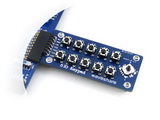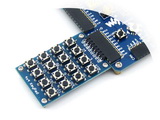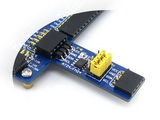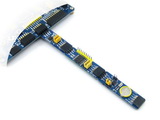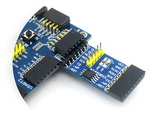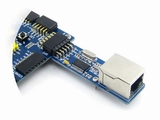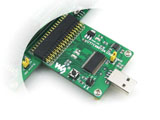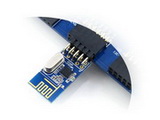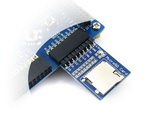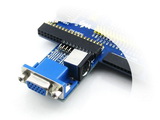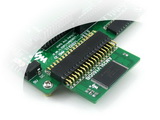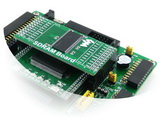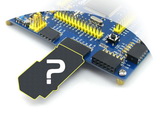Details

Overview
OpenEP4CE6-C is an FPGA development board that consists of the mother board DVK601 and the FPGA core board CoreEP4CE6.
OpenEP4CE6-C supports further expansion with various optional accessory boards for specific application. The modular and open design makes it the ideal for starting application development with ALTERA Cyclone IV series FPGA devices. OpenEP4CE6-C enables you to start your design with the Nios II processor easily and quickly.
What's on the mother board
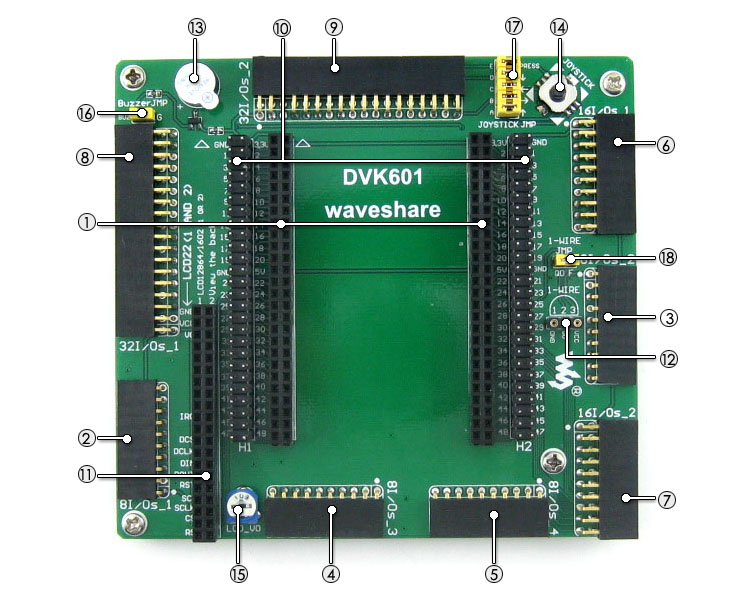
- FPGA CPLD core board connector: for easily connecting core boards which integrate an FPGA CPLD chip onboard
- 8I/Os_1 interface, for connecting accessory boards/modules
- 8I/Os_2 interface, for connecting accessory boards/modules
- 8I/Os_3 interface, for connecting accessory boards/modules
- 8I/Os_4 interface, for connecting accessory boards/modules
- 16I/Os_1 interface, for connecting accessory boards/modules
- 16I/Os_2 interface, for connecting accessory boards/modules
- 32I/Os_1 interface, for connecting accessory boards/modules
- 32I/Os_2 interface, for connecting accessory boards/modules
All the I/O interfaces above:
- capable of being simulated as USART, I2C, SPI, PS/2, etc.
- capable of driving devices such as FRAM, FLASH, USB, Ethernet, etc.
- FPGA expansion connectors
- FPGA pins are accessible on expansion connectors
- for connecting SDRAM accessory board
- LCD interface, for connecting LCD22, LCD12864, LCD1602
- ONE-WIRE interface: easily connects to ONE-WIRE devices (TO-92 package), such as temperature sensor (DS18B20), electronic registration number (DS2401), etc.
- Buzzer
- Joystick: five positions
- Potentiometer: for LCD22 backlight adjustment, or LCD12864, LCD1602 contrast adjustment
- Buzzer jumper
- Joystick jumper
- ONE-WIRE jumper
For jumpers 16-18:
- short the jumper to connect to I/Os used in example code
- open the jumper to connect to other custom pins via jumper wires
The DVK601 supports a wide range of different core boards, therefore, some of the interfaces may be Not-Connected and useless while connecting to certain core board. For instance, while connecting to Core3S250E, the '④ 8I/Os_3' and '⑤ 8I/Os_4' are Not-Connected.
What's on the CoreEP4CE6
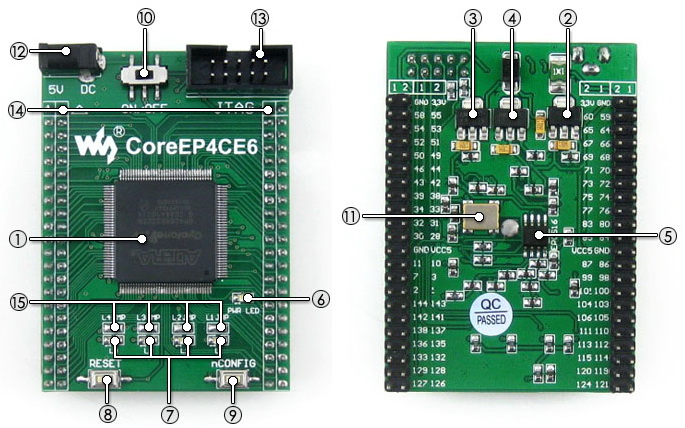
- EP4CE6E22C8N:the ALTERA Cyclone IV FPGA device which features:
- Operating Frequency: 50MHz
- Operating Voltage: 1.15V~3.465V
- Package: QFP144
- I/Os: 80
- LEs: 6K
- RAM: 270kb
- PLLs: 2
- Debugging/Programming: supports JTAG
- AMS1117-3.3, 3.3V voltage regulator
- AMS1117-2.5, 2.5V voltage regulator
- AMS1117-1.2, 1.2V voltage regulator
- EPCS16, onboard serial FLASH memory, for storing code
- Power indicator
- LEDs
- Reset button
- nCONFIG button: for re-configuring the FPGA chip, the equivalent of power reseting
- Power switch
- 50M active crystal oscillator
- 5V DC jack
- JTAG interface: for debugging/programming
- FPGA pins expander, VCC, GND and all the I/O ports are accessible on expansion connectors for further expansion
- LED jumpers
Photos
Note: The OpenEP4CE6-C does NOT integrate any programming/debugging function, a programmer/debugger is required.
Examples
The OpenEP4CE6-C FPGA development board comes with various examples codes for the supported peripherals, which give you a quick start to develop your own application.
| Peripheral | Description | Interface | Verilog | VHDL | NIOS II C |
|---|---|---|---|---|---|
| S29GL128P | NorFLASH | 32I/Os | Y | ||
| AT24CXX | EEPROM | I2C | √ | √ | √ |
| FM24CXX | FRAM | I2C | √ | √ | √ |
| AT45DBXX | DATAFLASH | SPI | √ | ||
| SD card | FLASH | SPI | √ | ||
| H57V1262GTR | SDRAM | parallel | √ | ||
| PCF8563 | RTC | I2C | √ | ||
| DS18B20 | Temperature sensor | 1-WIRE | √ | √ | √ |
| SP3232 | Serial communication | UART | √ | √ | √ |
| SP3485 | Serial communication | UART | √ | √ | √ |
| PL2303 | USB TO UART | UART | √ | √ | √ |
| FT245 | USB TO FIFO | parallel | √ | ||
| CY7C68013A | USB DEVICE | I/Os | √ | ||
| ENC28J60 | Ethernet controller | SPI | √ | ||
| Buzzer | Sound device | 1I/O (PWM) | √ | √ | √ |
| PS/2 keyboard | Input device | PS/2 | √ | √ | |
| Single buttons | Input device | ---- | √ | √ | √ |
| 4x4 keypad | Input device | 8I/Os | √ | √ | √ |
| Joystick | Input device | 5I/Os | √ | √ | √ |
| LED | Display device | ---- | √ | √ | √ |
| 8 SEG LED | Display device | 13I/Os | √ | √ | √ |
| VGA monitor | Display device | VGA | √ | √ | |
| Character LCD | Display device | 11I/Os | √ | √ | |
| Graphic LCD | Display device | 11I/Os | √ | ||
| 3.2 inch multi-color LCD + touch screen | Display device + Input device | 32I/Os | √ |
Debugging/Programming Interface
The OpenEP4CE6-C FPGA development board integrates JTAG interface for programming/debugging.
JTAG Signal Names & Description
| Pin | Signal Name | Description |
|---|---|---|
| 1 | TCK | Clock signal |
| 2 | GND | Signal ground |
| 3 | TDO | Data from device |
| 4 | VCC(TRGT) | Target power supply |
| 5 | TMS | JTAG state machine control |
| 6 | NC | No connect |
| 7 | NC | No connect |
| 8 | NC | No connect |
| 9 | TDI | Data to device |
| 10 | GND | Signal ground |
JTAG Header Pinout
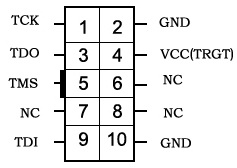
Development Resources
- Related Software (Quaters II, NIOS II etc.)
- Demo Code (Verilog, VHDL and NIOS II C)
- Schematic (PDF)
- FPGA Development Documentations (Datasheets etc.)



